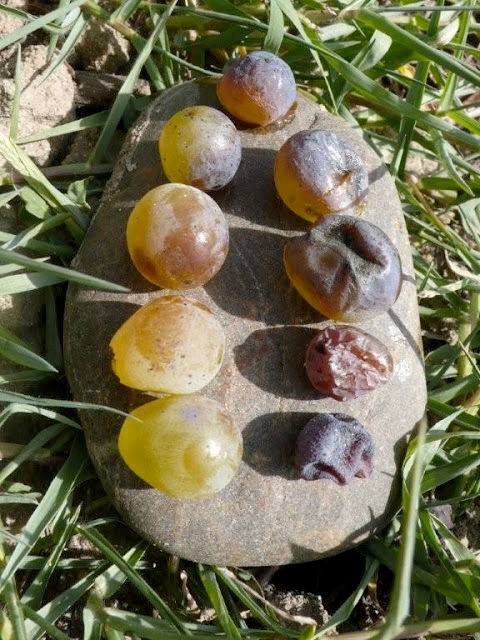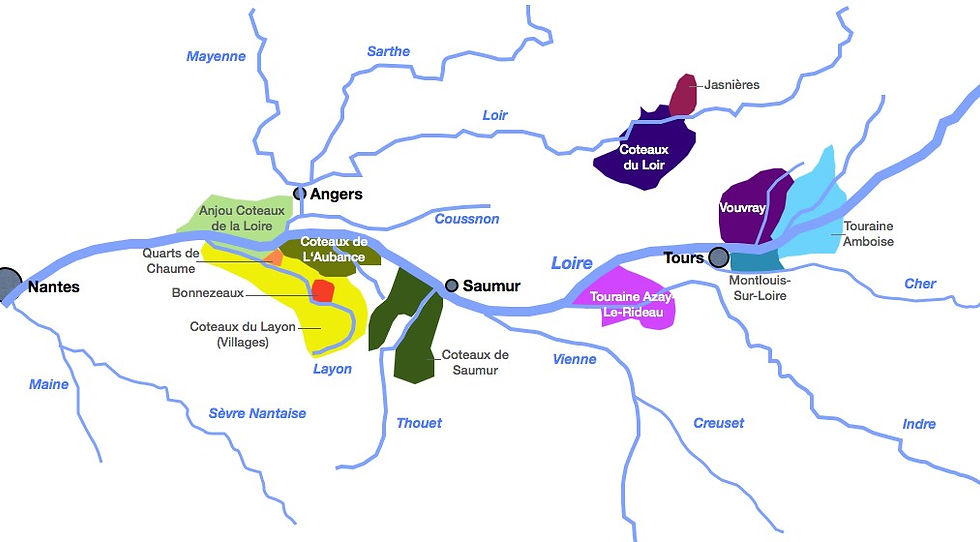ARE THOSE GRAPES GOOD FOR WINE?
This fungus is called "Botrytis Cinerea" or "Noble Rot" and helps to make some of the most expensive sweet wines around the world.

Botrytis is a fungus that can grow on ripe grapes causing noble rot. It make tiny holes in the skin of the grape, which cause the water inside of the grape to evaporate. This concentrated the acids, sugars, and flavors of the grape. The fungus can easily destroy grapes, and the right conditions are needed if it is to be beneficial. When conditions are just right, the fungus instead of destroying a crop, it creates grapes with incredibly concentrated flavor that can make some of the World's Sweetest, most precious wines.

In Sauternes, France botrytis slowly develops into noble rot on ripe grapes and gives the wine unique aromas, colour, and flavour. Note the golden colour of grapes changing to grey as the infection increases - http://www.myquem.com/noble-rot/
The ideal conditions in the vineyard are damp misty mornings that can provide moisture to allow the growth and spread of the fungus, followed by warm, dry afternoons to limit the growth of the fungus and prevent it from destroying the grapes. After few hours, sunshine and otherwise dry conditions must follow. This evaporates moisture and stops the fungus.
Grapes affected by this fungus are nearly always used to make sweet wines.
Noble Rot doesn't look pretty but their juice however is golden, sweet and precious. Each grape needs to be handpicked individually, and yields are tiny. The wines that result from this fungus, become very complex, concentrated and can be aged for many many decades.

Countries that have the perfect conditions to make this Special Type of Wines are:
Hungary: Tokaj-Hegyalja region in the Northwest
Austria's warmer East: Burgenland.
Germany: Rheingau, Nahe, Mosel, Rhin, and Pfalz
France: Alsace, Loire Valley, Bordeaux, and Southwest France.
1.- Hungary: Tokaj-Hegyalja region in the Northwest

THE GRAPES OF TOKAJI
Furmint
Harslevelu
Kabar
Koverszolo
Zeta
Sargamuskotaly
STYLES OF TOKAJI
Aszu
3 Puttonyos
min 60 grams sugar /liter (Term discontinued since 2013).
4 Puttonyos
min 90 grams sugar /liter (Term discontinued since 2013).
5 Puttonyos
min 120 grams sugar /liter (Since 2013 5p is labeled "Aszu").
6 Puttonyos
min 150 grams sugar /liter
Aszueszencia
min 180 - 450 grams sugar /liter (Term discontinued since 2013).
Eszencia
Szamorodni
Forditas
Maslas
The Tokaj-Hegyalja region in northeast Hungary and Southwest Slovakia. It said to be home to the oldest botrytized wines in the world. Tokaj receive early morning fog that wafts off the nearby Tizsa and Bodrog rivers. This helps top create the ideal conditions for the noble rot to develop. The grapes are harvested separately in 20-liters buckets called Puttonyos.
Traditionally the number of puttonyos used has been proportional to the sweetness level of Tokaji.
Eszencia: This wine rarely reaches above 3% ABV. This wine is so sweet , that usually it is often served from a tablespoon. 450 + grams sugar/liter.
Szamorodni: A wine made with separating noble rot grapes from regular grapes. The term basically translates to "made by itself" and requires less hand processing.
Edes = sweet with 45g/l sugar
Szaraz = dry with 9g/l sugar usually made in a nutty oxidative style.
Forditas: A wine produce with grape must, pomace or wine blended with the used pomace (seeds, skins, etc.) from Aszu wines.
Maslas: A wine produced with grape must, pomace or wine blended with the used wine less (dead yeast and leftovers wibe) from Aszu wine.
2.- Austria: East, Burgenland.

Austria's warmer east has the Lake Neusiedl. It helps to creates the perfect conditions for botrytis. The shallow lake ensures misty mornings with enough moisture for noble tor to develop. If we hone in on Austrian dessert wines, there is evidence that an early botrytis wine was made in Burgenland since at least 1526.
In Burgeland, the Seewinkel sub-region is especially good for sweet wine because if its unique wetlands. In the fall, shallow lake Neusiedl casts a fog. Vineyards creep to the edges of the wetlands and soak in the fog until intense sunshine burns it off. The fog encourages botrytis, and the sunlight helps the grapes ripen while keeping botrytis in check. This unique conditins make the area perfect for the producing noble beerenauslesen and trockenbeerenauslesen.
GRAPES: Blauer Zweigelt, Blaufrankisch and, Sankt Laurent.
3.- Germany: Rheingau, Nahe, Mosel, Rhin, and Pfalz.
The great botrytized wines of Germany are defined by wonderful aromas and juicy, sweet fruit balanced against the acidity. Riesling is considered the noblest of the botrytis-friendly grapes here, with the intense aromas and complexity fruit, spice, and mineral.
The warmer regions of Reingau, Nahe, and Pfalz. In the Franken region, RIESLING, as well as varieties like SILVANER, and RIESLANER, often yield more muscular yet sublimely herb-inflected wine.

Large bodies of water adjacent to vineyards moderate cool, northerly climates and allow grapes to ripen through an extended growing season. Mist form by the rivers contributes humidity that encourages botrytis growth and the transformation of pristine grapes into shriveled fruit bombs of sugar, spice and acidity.
It is no coincidence that the greatest botrytized wine from Germany, originated from vineyards that overlook the Mosel, Rhine, Nahe or main rivers.
To preserve primary fruit character and vibrant acidity. German winemakers avoid new oak during fermentation or maturation, which alters aromas and flavors, or they avoid malolactic too which soften the acidity.
4. France: Alsace, Loire Valley, Bordeaux, and Southwest France.
LOIRE VALLEY
Only 2 regions of the Loire Valley, which surrounds the Loire, France's longest river, where are designated as consistent enough to make botrytized wines: Layon River Valley, and Vouvray. Both rely on a thin-skinned Chenin Blanc that balances crisp delicacy and extreme richness.
* LAYON RIVER VALLEY OR COTEAUX DU LAYON AOC: It is situated in the Anjou district of the region, along the river Layon. In Touraine Azay-le-Rideau. Touraine Amboise and Montlouis-sur-Loire sweet wines (Moelleux) are produce from very mature grapes.
Anjou and Coteaux Du Layon A larger region to the west of Vouvray that has special focus on sweet Chenin Blanc and Sparkling wines. For sweet wines the Coteaux du Layon makes stupendous sweet wines made with noble rot. Within Coteaux, there are few sub-regions that produces the most expensive sweet Chenin Blanc in the world, including:
Quarts de Chaume AOP/AOC
Bonnezeaux AOC
Several appellations capture essential morning mist from the step Layon riverbanks, which includes Coteaus du Layon and Villages-designated Coteaux du Layon, such as "Beaulieu", "Chaume","la Faye",or "Saint-Aubin". The greatest selection, however, are from Quarts de Chaume (Loire's only GRAND CRU). and Bonnezeaux.
* VOUVRAY: It's 80 miles up river, produce any style of white. A white wine made with Chenin Blanc grapes that grow along the banks of the Loire River in the Touraine district of France, and is part of the Middle Loire Valley.
"Vouvray is Chenin Blanc, and a certain extend Chenin Blanc is a Vouvray" Jancis Robinson.
Chenin Blanc Botrytized wines are produce in small quantities and are frequantly richer than those from the Layon area.

BORDEAUX
The delicious sweet wines from Bordeaux region sometimes called late Harvest wines. Traditionally the harvest take a place on September, but the grapes for the sweet wines are harvested much later, usually from 1-2 months more.
The grapes purposefully left on the vine past the point as which they would be picked for other wines. The grapes left on the vine past the point at which they reach the peak ripeness, allowing individual grapes to slowly dehydrate over the time, concentrating their sugar content.
However, the most exciting part of this wines, it is the element in the entire lifecycle of sweet wines. It must be introduce by nature: Botrytis Cinerea, or Noble Rot a benevolent fungus that also give us the famous blue chees, stilton.
A specific set of conditions are necessary for Noble Rot to take hold, and it all begins with morning mist envelop entire vineyards. When those misty mornings are follow by dry, sunny afternoons, botrytis perforates nearby grape skin and allows moisture trapped inside the grapes to evaporate when dry conditions return. This cycle happens again and again throughout Autumn, increasing the concentration of sugar in the remain grape juice.
Sauternes and Barsac:
They are situated close to the Garonne and Ciron rivers. Those bodies of water, with their different temperature aids in the development of Noble Rot or Botrytis.
With the different temperatures helps to create the early morning misty conditions. In the best vintage, the early morning mist and fog gives way to warm afternoons, which allows the much desired rot to develop. The elevation in Sauternes range from 3 meters up to 80 meters, (262feet). The highest peak in Sauternes is located on the top of the hill at Chateau d'Yquem at 80 meters.

The rest of the regions produce sweet wines but just by Late Harvest, not by botrytis.

SOUTHWEST FRANCE
Within the greater Southwest, two appellations are worth for botrytized wines: MONBAZILLAC on the Dordogne river, and GAILLAC located on the Tarn River, northwest of Toulouse, relies on Mauzac for its botrytized wines.
REFERENCES:
Collection chateau.com
WineEnthusiast
Wine Folly


Comments